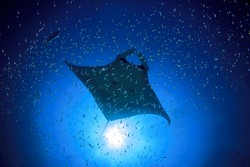New approach to ecosystem assessment
Nitrogen fixation is the main source of nitrogen in the open ocean and a crucial factor for primary production at the base of the food web. This, in turn, is linked to the exchange of carbon dioxide between the atmosphere and the sea, where it is consumed during biomass production and emitted during respiration. Iron can be a limiting nutrient for nitrogen fixation and/or primary production and is supplied to the open ocean mainly via dust deposition. As a reflection of increased desertification and changing land use, global deposition of dust is therefore of international interest. The EU-funded PROTEON (Proteomic approaches to assess the oceanic nitrogen biogeochemistry) project has developed a unique throughput approach to link the metabolic activity of organisms to their identity in a given sample. The analysis is based on the natural carbon (and nitrogen) isotopes of proteins present in an ecosystem. Two bacterial cultures were used to develop the high throughput approach which still has to be tested on a sample from a meromictic lake (a lake with layers that do not mix). Preliminary work on the lake’s microbial community and the sulphur cycle has been published in Geobiology. The technique, ‘Protein stable isotope fingerprinting’ (P-SIF), has so far been developed for carbon isotopes. Details of the work were published in the peer-reviewed journal Analytical Chemistry. Nitrogen isotopes proved more problematic, but work is continuing to resolve the technical difficulties. Protein extraction from seawater is also on the agenda, and the researchers will work on increasing the amount of protein for input into P-SIF for further resolution and in order to analyse samples from the tropical North Atlantic collected on a cruise. The samples were collected during a research voyage between Guadeloupe (French West Indies) and the Cape Verde Islands (West Africa), and subsamples were analysed with respect to bulk primary production and N2 fixation rates and the prevailing N2-fixing community. These experiments were conducted together with measurements of dust/aerosol thickness, enabling an indirect comparison of N2 fixation rates with projected dust input into the tropical North Atlantic. The P-SIF technique developed during PROTEON will be a valuable tool for evaluating the link between marine microorganisms and their role in the ecosystem. It will allow the study of previously unknown microbes, which may prove crucial in understanding biogeochemical processes in the environment and could help in assessing changes in land use.







